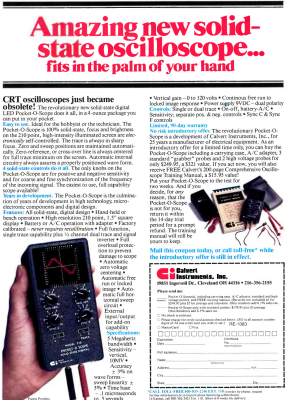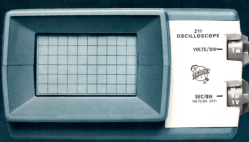 In the 1980s, an oscilloscope was typically a bulky affair with a large CRT, and a heavy power supply. So it probably grabbed a lot of attention in 1983 when Calvert Instruments Incorporated ran an ad in magazines like Radio Electronics. The ad touted a 5 MHz scope that was pocket-sized and weighed 4 ounces. The ad proudly proclaimed: CRT oscilloscopes just became obsolete!
In the 1980s, an oscilloscope was typically a bulky affair with a large CRT, and a heavy power supply. So it probably grabbed a lot of attention in 1983 when Calvert Instruments Incorporated ran an ad in magazines like Radio Electronics. The ad touted a 5 MHz scope that was pocket-sized and weighed 4 ounces. The ad proudly proclaimed: CRT oscilloscopes just became obsolete!
Indeed they would, but if you are wondering who Calvert Instruments was, so are we. We have never heard of them before or since, and we don’t know for certain if any of these devices were ever actually produced. What did it use instead of a CRT? The CI Model 210 Pocket-O-Scope was not only solid state but used an LED screen 1.5 inches square. That’s small, but it packed in 210 LEDs for “high resolution.” We assume that was also the genesis of the model number. Judging from the product picture, there were 14 LEDs in the X direction and 15 in the Y direction. High resolution, for sure!
There were some early LCD scopes (like the Iskrascope and one from Scopex) around the same time, but it would be the 1990s before we would see LCD oscilloscopes and even longer before CRTs were totally squeezed out.
Choices and What about Tektronix?
The ad made two offers. For $180 you could get the unit with “standard probes” that look like they belong with a multimeter. For $250 you could add the carrying case, an AC adapter, high voltage probes that still looked like multimeter probes, and a 200-page training manual.

For perspective, $180 in 1983 is worth about $540 today, and $250 would have set back the intrepid hobbyist the equivalent of $750 in today’s money. Moreover, a Tektronix 211 — a comparable CRT scope from the mid-1970s — was a 500 kHz portable scope with 10 NiCads weighed in at a little over 3 pounds. It cost $545 (in 1972 dollars), but you did get a larger analog screen.
While it is true that the 211 was a bit older than the CI 210, later, there were more expensive and more capable 200-series models that had dual channels and higher bandwidths. But not none of them would ever be able to get to four ounces! Phillips and Measuring Instruments also had similar entries.
Other Contemporary Choices
 The Tektronix T202, was a very similar idea to the model 210, but didn’t appear until 1989. It had two channels, a 5 MHz bandwidth, and a 128×128 monochrome LCD. It was a rebranded unit made by another company.
The Tektronix T202, was a very similar idea to the model 210, but didn’t appear until 1989. It had two channels, a 5 MHz bandwidth, and a 128×128 monochrome LCD. It was a rebranded unit made by another company.
A more common item was the NLS miniscope which was similar to the Tektronix 211, but much less expensive. They were available at least by 1977 and also weighed under 4 pounds, including batteries and the CRT. A 15 MHz unit cost around $300 if you include a probe. You can see a slightly newer model of the NLS in the video below.
What Do You Think?
While many of the scopes mentioned have something in common with the Calvert Instrument scope, there is one difference: we know all of these were actually made. The ads for the Calvert appeared, as far as we can tell, in October of 1983 and vanished after the February 1984 issue. They only appeared in Radio Electronics and we never found any other mention of the company. Was it vaporware? Or was the world just not ready for a 210-pixel LED scope? There were a few later construction projects of similar design, like this one on page 33 of this old Popular Electronics from 1997. For that matter, we’ve seen some contemporary builds with LEDs. But most of the modern toy scopes we see use some sort of LCD. You can only wonder what someone who bought a Tektronix 211 back in the day would think of our Owon HDS272S?
Maybe a Hackaday reader knows the story behind these. If you’ve ever seen a real one or know anything about the mysterious Calvert Instruments, do leave a comment.
Some photos in this post came to us via the excellent TekWiki. Others are from World Radio History scans.
"gadget" - Google News
April 15, 2023
https://ift.tt/8BTolMK
Retro Gadgets: The 1983 Pocket Oscilloscope - Hackaday
"gadget" - Google News
https://ift.tt/T15tqHL
Bagikan Berita Ini















0 Response to "Retro Gadgets: The 1983 Pocket Oscilloscope - Hackaday"
Post a Comment